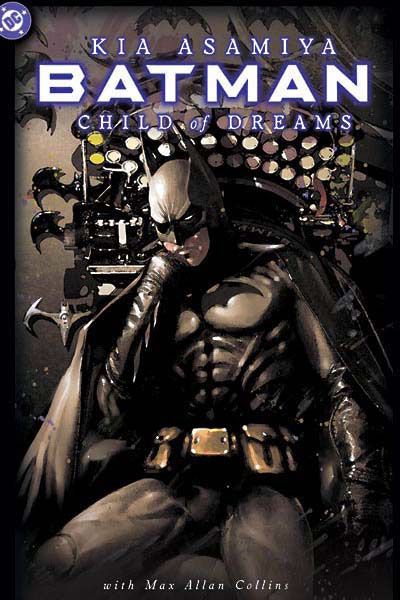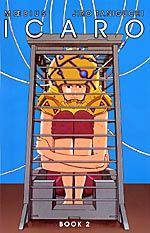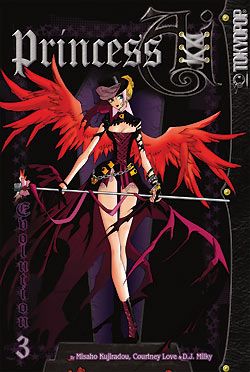I could go into the whole "manga-inspired comics" debate, but I really don't want to, as I like good manga no matter where it comes from. One of my current favorites, in fact, is a series of self-published doujinshi drawn by Jo Chen. Thankfully, manga-style comics from other countries are much more widely accepted today, as Yen Press has an entire line of domestically-produced manga adaptations of YA novels that I suspect does quite well. There are still many purists and older fans that insist manga can only come from Japan, however. This article covers three series that are, in theory, the best of both worlds. All three are drawn by Japanese artists (in two instances, very well-established Japanese artists), and all three were serialized in Japanese anthology magazines, the origin of all manga released in Japan. But all three were written by non-Japanese authors. Sadly, none of these are terribly stand-out series, but that the collaboration exists at all is quite interesting to me.
Batman: Child of Dreams - story and art by Kia Asamiya, adaptation by Max Allan Collins (1 volume)
Ha! Bet you didn't think I would cover Batman in here! I actually love one-shot Batman volumes like this, and I also really like Max Allan Collins (Road to Perdition, among other projects), so this one had a couple things going for it. This ran in Kodansha's Magazine Z in Japan, and was compiled into one volume in the US and flipped to read left-to-right for American audiences, which made Two-Face more entertaining. Kia Asamiya's involvement is interesting, as he is an unashamedly commercial artist that likes to ride current trends. A number of his works were translated into English when this came out (2000-2002, most famously Silent Moebius), and he was popular at the time, which might be why he was chosen or given permission for this project. The story itself is fairly interesting, the conflict revolving around a drug that makes your dreams come true by shapeshifting you into whoever it is you desire, the catch being that the drug kills you after 24 hours. Batman begins tracing the drug when he realizes that several of his usual foes aren't quite the real thing, and are in fact victims of this drug. The story travels to Tokyo as Batman runs down the source. Unfortunately, I haven't read more than the opening to this book, though the general story sounds much more interesting than the other two works I'm featuring tonight. Asamiya has very slick, serviceable art. Not a whole lot of detail, but the action flows well. He has a very distinctive style of character design though, and his angular faces threw me off in the bit I read. This graphic novel is out of print, but used copies are fairly cheap.
Icaro - Story by Moebius, Art by Jiro Taniguchi (2 volumes)
This was an extremely low-profile release, so much so that I can't find much information online. It was published by iBooks, who filed for bankruptcy immediately after it was released. It ran in Kodansha's Morning magazine, which has been home to many big hits over the years, including the venerable Vagabond, by Takehiko Inoue. I was shocked when I learned about Icaro years later, as it seems like more people would have talked about and read a collaboration between two superstars like Moebius and Jiro Taniguchi (The Walking Man, Samurai Legend). The story itself is a disappointment, however. It has several memorable sequences, like the opening where a naked pregnant woman is flying through the sky, a dream she has while giving birth to the titular Icaro, who has a flying psychic mutation. Or the scene immediately after, which interrupts two lesbian military officiers mid-coitus. From there, though, it gets rather humdrum, as it's revealed that Icaro is "adopted" and kept in captivity due to his powers of flight in hopes that he can be useful to the military someday. After a time, he tries to escape, and there are some fantastic chase sequences and some moral complications as scientists debate over the best ways to "pacify" him. But Icaro isn't that interesting a character, and none of the others are developed that well either. There are a few good ideas scattered throughout, but it makes for a rather bland whole. Taniguchi's art is in top form, with a lot of love going into the buildings and sci-fi scenery. Icaro can be difficult to track down and is occasionally pricey online, but both volumes look to be affordable right now. It's worth having for the unlikely writer/artist pair, but the work itself falls flat.
Princess Ai - Story by DJ Milky and Courtney Love, Art by Misaho Kujirado (3 volumes)
This was one of Tokyopop's flagship titles for a time, and for good reason. DJ Milky was a pseudonym for Stu Levy, the owner of the company. Courtney Love's involvement is more ambiguous, but aside from the main character being named after her (ai is Japanese for love), the story was said to have been inspired by a trip Love took to Japan. The series ran in Shinshokan's fairly prestigious Wings Magazine in Japan, and has been translated into several languages and was popular enough to generate a sequel and half a dozen spin-off volumes. It was popular, make no mistake, and Princess Ai even appeared as a full front page illustration on the Chicago Red Eye, as the postergirl of the Manga Revolution. To sweeten the pot, artist Ai Yazawa (Nana) was also commissioned to do the character designs. Unfortunately, it's a fairly weak series, but to be fair, it seems like it was aimed at a preteen/early teen girl audience, and it was successful enough to land many fans in that demographic. Ai wakes up with no memory, but with a great singing voice and a talent for performance, she quickly finds a place at Club Cupid, and even begins a relationship with a fellow musician named Kent. Turns out, Ai is an alien princess who is half angel, and she has the power to control people's emotions with her singing. Her home world, Ai-Land, is at war, and several of the nasty elements spill over into her new life on Earth. There's a little romance, a little action, and a fairly standard manga plot in play here. While it isn't nearly as bad as its background might make you believe, it is very mediocre. Kujirado's art is serviceable, and the best part really is the pretty character designs and costumes. It is a curiousity, as it is something like a vanity press book that went on to make big bucks, but it isn't necessarily worth seeking out unless you want to confirm for yourself it isn't terrible. It was published in three volumes, but a one-volume omnibus does exist.




